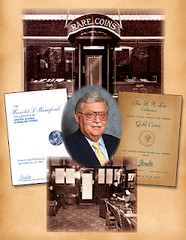
About UsThe Numismatic Bibliomania Society is a non-profit organization promoting numismatic literature. For more information please see our web site at coinbooks.org SubscriptionsThose wishing to become new E-Sylum subscribers (or wishing to Unsubscribe) can go to the following web page link MembershipThere is a membership application available on the web site Membership Application To join, print the application and return it with your check to the address printed on the application. Membership is only $15 to addresses in the U.S., $20 for First Class mail, and $25 elsewhere. For those without web access, write to: David M. Sundman, Secretary/TreasurerNumismatic Bibliomania
Society AsylumFor Asylum mailing address changes and other membership questions, contact David at this email address: dsundman@LittletonCoin.com SubmissionsTo submit items for publication in The E-Sylum, just Reply to this message, or write to the Editor at this address: whomren@coinlibrary.com
BUY THE BOOK BEFORE THE COINYou won't regret it! |
- WAYNE'S WORDS: THE E-SYLUM FEBRUARY 19, 2012
- THE FIRST REGIONAL CONVENTION OF THE NUMISMATIC BIBLIOMANIA SOCIETY
- BOOK REVIEW: THE GUIDE BOOK OF CANADIAN COINS AND TOKENS
- ROBERT J. MYERS 1934 - 2012
- BERT BRESSETT, 1925-2012
- CAMEO INCRUSTATIONS AND THE ADAM ECKFELDT PITCHER
- QUERY: WHERE ARE THE PINCHES' WYON MEDAL DIES TODAY?
- ON THE EDUARD KANN MANUSCRIPTS ON CHINESE PAPER MONEY
- QUERY: REGINALD HUTH INFORMATION SOUGHT
- NOTES FROM E-SYLUM READERS: FEBRUARY 19, 2012
- CALL FOR PAPERS: 2012 MEMPHIS INTERNATIONAL PAPER MONEY SHOW
- MET BUYS SAINT-GAUDENS STATUETTE: ABRAHAM LINCOLN, THE MAN
- H.M.S. VICTORY WRECK MAY HOLD TROVE OF GOLD
- COINS OF CHARLEMAGNE AND THE POPES
- JOHN MCQUEEN'S 1978 MIAMI BEACH AUCTION
- HARVEY STACK REMEMBERS HAROLD BAREFORD
- OBAMA AWARDS NATIONAL MEDALS OF ARTS HUMANITIES
- FIRST EXAMPLE OF GLOUCESTER-MINTED COIN OF WILLIAM I FOUND
- GOLD COIN STASH RAINS FROM RAFTERS IN FRANCE
- SPECULATORS FUEL BANK OF CHINA COMMEMORATIVE NOTE FRENZY
- NEW DOCUMENTS RECOUNT NAZI COUNTERFEITING DAMAGE
- FAKE U.S. BONDS SEIZED IN ZURICH
- FEATURED WEB SITE: THE TOKEN AND MEDAL SOCIETY
WAYNE'S WORDS: THE E-SYLUM FEBRUARY 19, 2012

New subscribers this week include J. Kramer. Welcome aboard! We have 1,510 email subscribers, plus 172 followers on Facebook.
This week we open with a look back at the 1983 Long Beach meeting of the NBS and a "mini-review" of Whitman's new Guide Book of Canadian Coins and Tokens. Next come remembrances of two numismatic personalities who passed on recently.
Other topics include the Wyon medal dies, Reginald Huth, a Saint-Gaudens statue, commemorative banknotes and reminiscences on John McQueen, Harvey Stack and Alan Weinberg.
To learn more about Harold Bareford, cameo incrustations, cardboard tokens from the Tea Gardens of Assam, the H.M.S. Victory's secret cargo of gold and the Token and Medal Society, read on. Have a great week, everyone!
Wayne Homren
(whomren@gmail.com)
Numismatic Bibliomania Society
THE FIRST REGIONAL CONVENTION OF THE NUMISMATIC BIBLIOMANIA SOCIETY
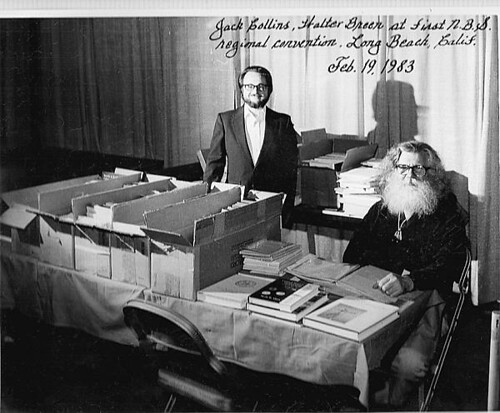
"As a coin collector, it's possible you've been called a "maniac." Only one numismatic organization is proud to consist entirely of maniacs - the Numismatic Bibliomania Society.
"How maniacal are NBS members about collecting numismatic books, catalogs, magazines and price lists? Its official journal is The Asylum, and its e-newsletter is The E-Sylum. The joke goes that you don't so much join the NBS as get committed to it."
To read the complete article, see: Want to be a (biblio)maniac? Get committed to the NBS (www.coinworld.com/articles/want-to-be-a-biblio-maniac/)
Cal Wilson wrote:
At the beginning of this issue, I mentioned that the first regional convention of the Numismatic Bibliomania Society was conducted in Long Beach, California on Feb. 19. The meeting was attended by nearly thirty members, and it was the consensus that it was indeed the finest and most interesting "get together" that our young organization has held to date.
George Kolbe moderated a most informative discussion of book binding and preservation; and he, Alan Meghrig and Armand Champa exhibited a number of beautiful pieces. The normally "reserved" Walter Breen was figuratively drooling all over Armand's prize, William Hartman Woodin's personal deluxe interleaved copy of Adams and Woodin's United States Pattern, Trial and Experimental Pieces. Annotated throughout the work were Woodin's notes containing information still not even included in Judd! Five'll get you ten that the eighth edition of Judd will have some new tidbits.
Oh! Incidentally, I was elected President of the N.B.S. for a two-year term. The other officers installed were Armand Champa, Vice President; Alan Meghrig, Treasurer; Linda Kolbe, Secretary; and Q. David Bowers, Remy Bourne, Carling Gresham, Don Pfau and Dick Punchard, members of the executive board.
BOOK REVIEW: THE GUIDE BOOK OF CANADIAN COINS AND TOKENS
 Last week I received my copy of The Guide Book of Canadian Coins and Tokens, by James A. Haxby. I'd been looking forward to this book, curious to see how the new Whitman publication would stack up in a world so used to the standard Charleton guides to Canadian coins and tokens. Of course, I have to admit that I'm far from up-to-date with the Charleton publications, and neither am I an active collector of Canadian material. So I'll stick to reviewing the book on its own merits. Let's call this a "mini-review".
Last week I received my copy of The Guide Book of Canadian Coins and Tokens, by James A. Haxby. I'd been looking forward to this book, curious to see how the new Whitman publication would stack up in a world so used to the standard Charleton guides to Canadian coins and tokens. Of course, I have to admit that I'm far from up-to-date with the Charleton publications, and neither am I an active collector of Canadian material. So I'll stick to reviewing the book on its own merits. Let's call this a "mini-review".
First, the book is recognizable as a Whitman guide book, with a similar format and layout to the classic "Red Book" or, A Guide Book of United States Coins. What's different of course, is stated in the title - the inclusion of tokens as well as official government coinage. There are pros and cons to this approach, but I think I like it. There are not so many different types of Canadian coins and tokens that they can't be covered in one volume, and it's a handy guide, even if it does stretch to 461 numbered pages.
The text beginning each section provides a succinct overview of the coin's development and history. The images are in color, actual size. For each coin type there is a table listing the date, mintage and value in various grades. Alternate lines are shaded, making it easy to read across the page. The layout is clean and readable, yet packs a lot of information in a small space.
The 35-page introduction provides a decent overview of Canadian coinage and includes a nice section on The Manufacture of Coinage Dies discussing the Royal Mint, the Heaton Mint, and later branch mints at Ottawa and Winnipeg. The "Mintmarks" That Aren't section notes that "several Canadian coins carry letter designations that could be mistaken for mintmarks but actually serve other purposes."
QUICK QUIZ: what to the letters A,B, and P designate on Canadian coins?
I was glad to see the token listings, which include Rutherford tokens, Tiffin tokens, Ships Colonies & Commerce tokens, Bouquet Sou tokens, and the Magdalen Island tokens.
I appreciated the "Concoctions for Collectors" section listing various "outright fabrications that have been on the numismatic scene for many years and in some cases have been highlights of various famous collections." These include muled tokens such as Breton 973 and 1001.
The book wisely references the key historical attribution guides for Canadian tokens such as Breton, as well as newer guides such as Withers. However, I was perplexed trying to locate any mention of these attribution references, either in the book's front material, glossary or bibliography. The bibliography is dreadful, in my opinion - it lists none of the references one would expect to have been consulted in compiling this guide. Rather, it is a one-page discussion of periodicals where one might find further information. In future editions I think this section should be renamed and replaced with a true bibliography.
In summary, I think this is a worthwhile one-volume reference for collectors who collect both coins and tokens of Canada, but it will not supplant more specialized guides that detail the vast array of token varieties. As with all first editions, there is room for improvement in subsequent editions, and I'll look forward to watching this book evolve.
To read an earlier E-Sylum article, see: NEW BOOK: THE GUIDE BOOK OF CANADIAN COINS AND TOKENS (www.coinbooks.org/esylum_v15n05a04.html)
ROBERT J. MYERS 1934 - 2012
George Kolbe forwarded an obituary of coin dealer Bob Myers.
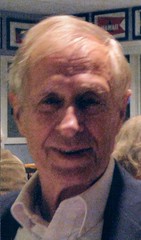 Myers Robert J., 77, of Fairfield, Connecticut and formerly of New York City died on February 14, 2012. He was born on December 31, 1934 in Grand Rapids, Michigan to the late Helen Oleson Myers and Charles Myers. Bob was the quintessential Renaissance Man who measured success not by fame or profit but by having integrity and by the pleasure and challenges of his endeavors. By that definition, he was a tremendously successful man in each of his careers.
Myers Robert J., 77, of Fairfield, Connecticut and formerly of New York City died on February 14, 2012. He was born on December 31, 1934 in Grand Rapids, Michigan to the late Helen Oleson Myers and Charles Myers. Bob was the quintessential Renaissance Man who measured success not by fame or profit but by having integrity and by the pleasure and challenges of his endeavors. By that definition, he was a tremendously successful man in each of his careers.
His formal training as a bio-chemist began informally at age 10 with a chemical laboratory in the family basement and as a teenaged Certified Pharmacist's Apprentice. When he was 13 an elderly man in Grand Rapids showed him a box of coins. That day he bought his first coin, a bronze of Augustus, and paid less than a dollar for it. Bob studied biochemistry at Indiana University supporting himself by starting a coin shop offering ancient and foreign coins.
He joined the Army where he was the official Signal Corps photographer. Because of his expertise in bio-lab work, Cornell Medical College brought him to New York to do medical research until the mid 1970's. All this time he was building an extensive library on numismatics and ancient art. In his "spare" time, he appeared in Off Broadway productions.
Bob Myers became an internationally recognized and respected dealer/appraiser of ancient coins and antiquities. He held his own auctions and obtained an auctioneer's license. Calling auctions in three languages in Switzerland was a challenge. Under his own name he issued 13 catalogues of ancient coins and antiquities. He was the author of several journal articles, prepared appraisals and was, on occasion, called by the IRS as expert witness.
Robert Myers was a man of exceptional generosity, intelligence and wit, the combination of which was irresistible. He had that rare quality of making everyone feel like royalty, tapping into their interests which by reason of his all-embracing knowledge were his as well. He was passionately devoted to his children and grandchildren, always seeing them as people, not just kids. They were adoringly enthralled in discussions of spiders or starfish, in beating grandpa at chess, handling ancient coins or learning to tie shoelaces in the "weird" Myers' double loop. He is survived by his life partner of 36 years, Rita Ortiga Waterman.
To read the complete obituary, see:
Robert J. Myers
(www.leskopolkefuneralhome.com/_mgxroot/page_10780.php?
task=Current&listing=All)
Robert J. Myers may not have been a close personal friend but he was an esteemed one. I would have first met Bob in the late 1970s at a New York coin convention, likely the New York International. Over the years, Bob always stopped by during the convention to say hello and to engage in pleasant conversation. He and I would run into each other at various other coin conventions and auction sales, both in the U.S. and in Europe, where his ability to seamlessly call auctions in several languages was a decided asset. Bob also regularly participated in my numismatic book auctions, adding to his already comprehensive library of works on ancient numismatics when, on occasion, he found one of a small number of works not already accessioned.
In September 2010, Kolbe & Fanning were honored to sell Bob's numismatic and archeological library, which was issued in the style of his well known series of ancient coin auction sales. The catalogue testifies to the breadth and depth of his library and his charming account of "A Numismatic Life" appearing therein modestly touches on his many interests and accomplishments.
Bob was a gentleman, always proper though not without a keen sense of humor. It was always a joy to be in his company. When David Fanning and I visited Bob in early 2010 to pack his library, my admiration grew. Though suffering from extreme back pain at the time, Bob was helpful throughout and stoically accepted his burden. It was there that David and I met perhaps his greatest asset, his partner Rita Waterman, whose devotion to Bob was complete.
While at Bob's NYC apartment, I admired a lovely, large medieval manuscript leaf. Bob insisted that I accept it as a gift and it now hangs on my wall. I think of Bob when I pass it and always will.
George F. Kolbe
February 2012
BERT BRESSETT, 1925-2012
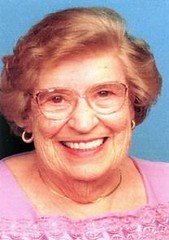 Bertha B. (Britton) Bressett, age 86, died peacefully in the hospital February 12, after many years of coping with COPD. She was born 1925 in Keene, New Hampshire, and attended schools there with special emphasis on Business Administration. She was married to Kenneth E. Bressett in 1950 and celebrated their 60th wedding anniversary with family and friends in 2010. She is the mother of three children, Philip E. Bressett (wife Joann) of Colorado Springs, Richard J. Bressett of Madison, Wisconsin, and Mary Elizabeth Sauder of Taunton, Massachusetts.
Bertha B. (Britton) Bressett, age 86, died peacefully in the hospital February 12, after many years of coping with COPD. She was born 1925 in Keene, New Hampshire, and attended schools there with special emphasis on Business Administration. She was married to Kenneth E. Bressett in 1950 and celebrated their 60th wedding anniversary with family and friends in 2010. She is the mother of three children, Philip E. Bressett (wife Joann) of Colorado Springs, Richard J. Bressett of Madison, Wisconsin, and Mary Elizabeth Sauder of Taunton, Massachusetts.
The Bressett family moved from Keene, N.H. to Racine, Wisconsin in 1959, and later spent two years in Des Moines, Iowa. "Bert", as she preferred to be known, moved with her husband to Colorado Springs, Colorado in 1982. She was a member of Saint Paul's Catholic Church.
Her parents, Elton and Rosamond Britton (Frizzell) preceded her in death, as did her sister Margaret Kingsbury. In addition to her immediate family that includes one grandson, she leaves her brother Carl Britton, of Peterborough, New Hampshire, a sister, Polly Courchene of Sebastian, Florida, and numerous cousins, nieces and nephews.
Much of her life was involved with doing volunteer work for various charitable organizations, and working with children. Among her many special interests were making ceramic ware, travel, reading and folk dancing. She frequently accompanied her husband on trips and was well-known as a hostess and volunteer worker at various numismatic events throughout the country.
To read Bert's full obituary and view a photo gllery, see: In Memory of Bertha Bressett September 28, 1925 - February 12, 2012
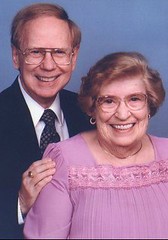 We received word of the passing on February 12, 2012, of Ken Bressett's wife Bert. Bert married Ken in 1950 and they have two sons and one daughter. Bert Bressett was well known in the numismatic hobby and it would be very hard to find a more loving, friendly, congenial, honest and family oriented person. Some years back when Bert was able to travel, we always enjoyed seeing and talking to Bert and her husband Ken at the coin shows and other events our paths crossed. We will always remember first meeting Bert, along with her luminary husband Ken when they lived in Racine, WI. At the many coin events we came in contact with Bert and Ken, she always greeted us with a hug and asked how we were doing. Our conversations always centered on family, the numismatic hobby and how other numismatists were doing.
We received word of the passing on February 12, 2012, of Ken Bressett's wife Bert. Bert married Ken in 1950 and they have two sons and one daughter. Bert Bressett was well known in the numismatic hobby and it would be very hard to find a more loving, friendly, congenial, honest and family oriented person. Some years back when Bert was able to travel, we always enjoyed seeing and talking to Bert and her husband Ken at the coin shows and other events our paths crossed. We will always remember first meeting Bert, along with her luminary husband Ken when they lived in Racine, WI. At the many coin events we came in contact with Bert and Ken, she always greeted us with a hug and asked how we were doing. Our conversations always centered on family, the numismatic hobby and how other numismatists were doing.
The last time we saw Bert was at American Numismatic Association Summer Seminar some years back. Bert attended the last day's event with her husband Ken. Though Bert was sick, she was smiling and talking about everyone else and how they were doing. When asked by the people she was talking to how she was doing, she smiled, and said fine. Like everyone else who knew Bert, we had a great love and affection for this friendly and loving person. At this last meeting with Bert at the ANA's Summer Seminar, and the many other conversations we had over the many years we knew her, they will always be remembered and cherished.
When Bert received the Numismatic News Ambassador Award in 1999 at the American Numismatic Association convention, one comment was that Bert Bressett's specialty in numismatics was people; it's been said that she "collects ,friends." Truer words have never been said about anyone and few in the hobby had a collection of friends as many as Bert had. It was also said that she has been one of the hobby's best representative to noncollectors and has been a great supporter of the ANA. It wasn't that many years back that Bert was an ANA National Volunteer. She assisted at pre-registration, banquet registration or any other place as needed. For over 60 years, this great person has been a collector, volunteer and loving wife of Ken and her family. Bert was a strong supporter of her husband Ken when he worked for Whitman, as an ANA employee and board member (he served as President), convention chairman,researcher, publisher & author. For Bert Bressett's service and dedication to the numismatic hobby, she not only received the coveted Numismatic News Ambassador Award in 1999; but also from the ANA, a President's Award in July, 2001, in 1993 the Medal of Merit and the Farran Zerbe in 1998.
Over many years we always thought about the health of Bert, and our nightly prayers always included her. In remembering Bert Bressett and her life Winston Churchill said it best, "We make a living by what we get, and we make a life by what we give." We think this says it all about our friend Bert Bressett. During her lifetime she brought not only great joy to her immediate family, but also the thousands of friends and others who crossed her path. All of our prayers and thoughts to Ken Bressett and his family. She will always be in our thoughts and prayers. With sincere sympathy, John and Nancy Wilson, Ocala, FL
CAMEO INCRUSTATIONS AND THE ADAM ECKFELDT PITCHER
While I cannot tell the Adam Eckfeldt family descendant where her family heirloom pitcher -- bearing the U.S. Mint's first chief coiner's portrait -- is located, or where there is another, I can reveal, however, how it was made.
This is one of the more charming USES of medals. For three decades as an employee of a medal manufacturer and later a medal dealer I often encountered naive people who asked. "What good are medals? What do you do with them?"
Over the years I developed a pat answer: "They provide longevity. They reveal something that happened in the past." Depending upon how long I could hold their attention I would continue talking about portraits of people long past, and events that are more accurate than historians -- or history books. And about the artists who created the medals -- engravers first, later sculptors working in clay models. And the beauty of medallic art. And ...
If they hadn't walked away from me by them I could keep on talking about how the artist's clay models are cast in plaster, then a metal shell -- a galvano -- is made from that plaster, then the metal pattern is mounted on a die-engraving pantograph to cut a die the size of the intended medal. Then ... I could still go on ... you see, I was a paid hack to talk about medals (although the title was "publicity director!").
Well, if your lady correspondent hasn't stopped reading this by now, perhaps she would like to know more about her pitcher and how it got her ancestor's portrait embedded in glass.
It's a process called incrustration, and those relief elements in glass are called cameo incrustations. They can appear clear, white, silvery or in full color. For the most part they were portraits or devices taken from medals, usually high-relief medals. But the relief in the glass ends up the exact size as the image on the medal -- no reduction or enlargement (unless it was remodeled).
 The process of incrustation was first done in Bohemia about 1750 and first called crystallo-ceramie, the first producers were ceramic makers. Cameo incrustations have been applied to a wide variety of glass objects including: paperweights, letter weights (somewhat larger), glass plaques, tumblers, goblets, cups, plates, flasks and bottles of many kinds, vases, obelisks, candlesticks, utilitarian objects as buttons and doorknobs, even jewelry. Oh yes, pitchers, like the Eckfeldt family example! A number of famous glass firms made these, like Baccarat.
The process of incrustation was first done in Bohemia about 1750 and first called crystallo-ceramie, the first producers were ceramic makers. Cameo incrustations have been applied to a wide variety of glass objects including: paperweights, letter weights (somewhat larger), glass plaques, tumblers, goblets, cups, plates, flasks and bottles of many kinds, vases, obelisks, candlesticks, utilitarian objects as buttons and doorknobs, even jewelry. Oh yes, pitchers, like the Eckfeldt family example! A number of famous glass firms made these, like Baccarat.
How made: a negative plaster mold is made of one side of a medal containing the desired image. A special clay-glass paste was used to form a positive cast from this mold; the clay cast would then be trimmed to the exact size of the relief part to be reproduced. The clay could be slightly bent at this time. That is how you could have a flat medal design in a round bottle or cup.
The surface of the clay is then treated for the color or transparency of the incrustation. If it was to be clear, it was coated with a molten glass substance; if silver was wanted, it would be coated with silver dye; if in full color it could have to be painted. Should the clay be left untreated a small portion of its surface would adhere to the glass object and take the color of the baked clay, somewhat of a chalky color.
The treated clay was then positioned in the mold for the glass object. The mold was most often of several parts and would be assembled into place. Molten glass is poured into the mold containing the clay relief. After the object had cooled the mold would be disassembled, the object was removed. The clay would be broken away and discarded. Only the treated surface containing the image would adhere to the glass object. It would appear in three dimensions (more accurately, in relief) and contain the color or clearness desired.
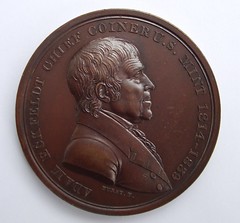
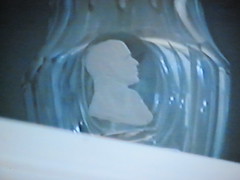
I have written about this unusual utilization of medals in The E-Sylum before (vol 10, no 31, art 11, August 5, 2007). I mentioned the major collection of these glass objects in the collections of the Corning Museum of Glass in Corning New York. Well worth the trip to visit.
Also the thrill for collectors is to do exactly what was illustrated in the article last week, match up the medal with the cameo incrustation. That's a thrill for all! I also mentioned the best book on the subject: Jokelson, Sulphides, 1968. Also Dunlap. The Jokelson Collection of Cameo Incrustations. 1991.
Alan V. Weinberg writes:
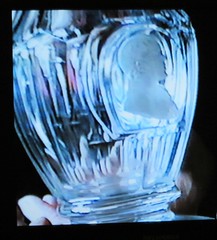 Please tell the Adam Eckfeldt descendant that the best way to locate the Eckfeldt glass vase is to send an image and a description and her info to the Maine Antique Digest.
Please tell the Adam Eckfeldt descendant that the best way to locate the Eckfeldt glass vase is to send an image and a description and her info to the Maine Antique Digest.
M.A.D. is the Wall Street Journal, the New York Times, the Coin World of the antique trade and collector world. It's issued once a month, is quite voluminous and is well known for publishing pictures and summaries of stolen , missing or descendant searches for a particular item. If the vase is out there or was seen, M.A.D. will uncover it.
To read the earlier E-Sylum articles, see:
MISSING ADAM ECKFELDT PITCHER SOUGHT
(www.coinbooks.org/esylum_v15n07a08.html)
NUMISMATIC GLASS SULPHIDES AT THE CORNING MUSEUM OF GLASS
(www.coinbooks.org/esylum_v10n31a11.html)
QUERY: WHERE ARE THE PINCHES' WYON MEDAL DIES TODAY?
Geoff Bell writes:
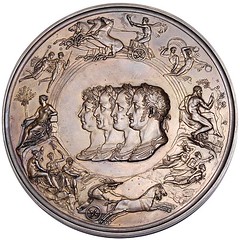 I read with interest the article and description of the Pinches advertising medal. I have a Pinches catalogue in my library dated 1967 advertising the Pistrucci Waterloo medal. Therefore we know the reproduction was done by that time.
I read with interest the article and description of the Pinches advertising medal. I have a Pinches catalogue in my library dated 1967 advertising the Pistrucci Waterloo medal. Therefore we know the reproduction was done by that time.
I visited the business in London in 1974. They were very careful not to allow me in where production was happening but to my delight I was escorted to a room upstairs. It was lighted with natural light much like the photographic studios of old and to my astonishment three elderly gentlemen were cleaning old dies of university, exhibition, agricultural , etc medals.
It was a treasure drove of old tools and the art form shown by these craftsmen was nearly a lost art. They quickly saw I was a serious collector of medals and appreciated their work. They opened up as if they had found a long lost friend. I often wonder what ever happened to all those dies! Of course, many of the dies were Wyon specimens. I love Wyon medals so you can only imagine my excitement.
To read the earlier E-Sylum article, see: NOTES FROM E-SYLUM READERS: FEBRUARY 12, 2012 (www.coinbooks.org/esylum_v15n07a09.html)
ON THE EDUARD KANN MANUSCRIPTS ON CHINESE PAPER MONEY
Joe Boling writes:
In response to Bruce Smith's question, an Eduard Kann manuscript on Chinese paper money was published in London in the 1960s. His given name was rendered as Edward. The work was published by mimeograph in three volumes of 35, 37, and 31 legal-sized pages, each volume bound by staples at the left edge. Only the covers were printed, by letterpress.
Volume I is titled Kann's History of Chinese Paper Money (Ancient), published by the International Banknote (sic) Society, with no date nor place of publication indicated. Volume II is titled Kann Part II: The Provincial Banks of China and Foreign Note-Issuing Banks in China. It was published by Transatlantic Authors Ltd, Mayfield, Kirby-road, Walton-on-Naze, Essex, again with no date shown. Volume III is titled Kann III: Government Banks of China. The publisher was again Transatlantic Authors Ltd, this time with a house number (103) on Kirby Road, and again without any date. Volumes I and II are in buff light card covers, and volume III in maroon light card.
These are, as the titles indicate, histories, not catalogs, although there are mentions of notes that have been seen on specific banks. The preface to volume I, signed by Colin Narbeth, mentions Kann's death in July 1962, so we can date the books after that. Based on Bruce Smith's description of the manuscript he is looking for, these books may be a compendium of the 46-part history from the Far Eastern Economic Review, and not the catalog that Bruce wants to recover.
Bruce W. Smith writes:
Those are indeed reprints from parts of Kann's 46 part series published in Far Eastern Economic Review (Hong Kong) in the 1950's. I don't believe the source was credited in the reprints and I suspect they were in violation of copyright protection. The whole series of reprints (3 parts I think) cover only about one fourth of the whole series.
The reprints are useful -- I wish the rest of the series had been reprinted. I had to xerox all 46 parts at Washington University library in St. Louis. The Far Eastern Economic Review is not so easy to find in the United States. I think there may be other articles by Kann there, as well as a series on Chinese currency by Frank H. H. King (who much later wrote the 4 volume history of the Hong Kong and Shanghai Banking Corporation).
To read the earlier E-Sylum article, see: QUERY: INFORMATION ON EDUARD KANN SOUGHT (www.coinbooks.org/esylum_v15n07a17.html)

QUERY: REGINALD HUTH INFORMATION SOUGHT
Neil Shafer writes:
I have a request for anyone who may be able to assist me. I would like to find out more about Reginald Huth, who made a number of ephemeral patterns of various kinds. Is there some sort of reference that provides more specific information than what's on the Internet?
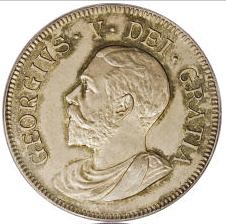 George V pattern Double-Florin, 1911, by Reginald Huth, struck in silver, Plain Edge. ESC-401. KM-PPn123.
the portrait shows King George in toga and ever so emperor-like, while the reverse design is a throng of mythic and emblematic creatures, including a dragon.
George V pattern Double-Florin, 1911, by Reginald Huth, struck in silver, Plain Edge. ESC-401. KM-PPn123.
the portrait shows King George in toga and ever so emperor-like, while the reverse design is a throng of mythic and emblematic creatures, including a dragon.
To read the complete auction lot description, see: Great Britain: George V pattern Double-Florin, 1911, by Reginald Huth (coins.ha.com/c/item.zx?saleNo=425&lotNo=51888)
NOTES FROM E-SYLUM READERS: FEBRUARY 19, 2012
Fred Berson Sought
Ron Abler writes:
I recently ran across a dark Xerox copy of a 1876 article in TAMS written by Fred Berson on U.S. Centennial Die Trials. I would very much like to ask him some questions. TAMS has no record of him after 1977. Does anyone happen to know him or someone who might, so that I can try to make contact?
Notes from Kavan Ratnatunga in Sri Lanka
Kavan Ratnatunga writes:
I wrote a short article for the Lankan Sunday Times of 12th Feb.
Anyone travelling by bus is affected by the shortage of small change. Bus conductors often ask for change, and if you don't have any, often doesn't return any.
They just ignore giving back a rupee or two, but some don't protest if they get a rupee or two less. Then give a conductor Rs 10, for the minimum bus fare of Rs 7, and he may return you Rs 5 or may ignore giving you back anything unless you ask for change. Small shops may give a toffee you don't need.
The number of coins issued is limited, since it costs the Central Bank (CB) more than the face value to mint coins, and CB encourages consumers to return coins into circulation rather than accumulate at home. In India however, customers insist on correct change and unable to get sufficient coins from the banks, traders have to pay a heavy premium to get the coins.
"For one (Indian) rupee coins worth Rs 100 one has to pay Rs 114, while for two rupee coins worth Rs 100 one has to pay Rs 115. For five rupee coins worth Rs 100 one has to pay Rs 118. These rates keep changing. During festivals, the premium goes as high as Rs 125 for coins worth Rs100," according to a Mumbai trader. Fed up with the coin shortage, the traders in the south Mumbai wholesale markets of Masjid Bunder and Bhendi Bazaar have hit upon an idea to use their own tokens which are honoured within their community, virtually like official currency. Such tokens of Rs.1 and Rs.2 denominations minted by the Mandvi-Koliwad Association (MKA) and put into 'circulation' early last month are proving to be an instant hit in the trading community reeling under official coin shortages and black-marketing of the small change.
To read the complete article, see: Travails of loose change for Lankan bus commuters (sundaytimes.lk/120212/BusinessTimes/bt15.html)
Kavan adds:
I was also fascinated by the Zero rupee Banknotes. See:
7137567/India-issues-zero-rupee-banknotes.html)
For a video, see: Novel campaign to challenge India's Bribe Culture: India ‘issues' Zero Rupee Banknotes (current.com/community/92052162_novel-campaign
-to-challenge-india-s-bribe-culture-india-issues-zero-rupee-banknotes.htm)
And in a final topic Kavan adds:
Today I found a very interesting BBC article. It also has some comments about the card board Tokens from the Tea Gardens of Assam - Just like the Coffee Tokens of Ceylon. IMHO they are technically not illegal as tokens.
It is a type of barter which is legal.
The error by MKA was to call them coins.
I would like to see what happens if RBI prosecutes.
I am still hopeful that I will get some of these tokens.
I am told it is an unsafe area of Mumbai
To read the complete article, see: Sharp practice of melting coins (news.bbc.co.uk/2/hi/6766563.stm)
CALL FOR PAPERS: 2012 MEMPHIS INTERNATIONAL PAPER MONEY SHOW
Call for Papers
Memphis Speakers Series
2012 Memphis International Paper Money Show
June 8-10, 2012
Memphis is the paper money speaking event of the year!
We invite presentations on any fiscal paper or fiscal paper tie-in topic. We will have a packed program.
Deadline for submissions is April 1st so we have time to organize the program and send out press releases advertising your talk.
Talks are scheduled on the hour throughout the show. Each talk is allotted 50 minutes, which includes time for questions. Speakers arrive 10 minutes before the hour for setup.
You must use Powerpoint for your visuals. No exceptions. Lavishly illustrate your talk. Bring your own laptop or submit a disk with the presentation to Peter Huntoon two weeks in advance of the show.
You are welcomed to mount a parallel exhibit in the exhibition area.
Application requirements:
(1) list of presenter(s) with full contact information for each,
(2) title of talk,
(3) catchy concise newsworthy description of the content of your talk - this will be your primary draw,
(4) special needs such as up to three display cases for show-and-tell items.
Send applications to peterhuntoon@embarqmail.com.
MET BUYS SAINT-GAUDENS STATUETTE: ABRAHAM LINCOLN, THE MAN
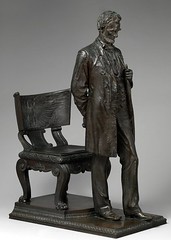 The Metropolitan Museum of Art has acquired one of only 16 known casts of Augustus Saint-Gaudens' Abraham Lincoln, the Man (Standing Lincoln), a rare, authorized reduction of the large bronze monument that the sculptor originally created for Lincoln Park in Chicago between 1884 and 1887.
The Metropolitan Museum of Art has acquired one of only 16 known casts of Augustus Saint-Gaudens' Abraham Lincoln, the Man (Standing Lincoln), a rare, authorized reduction of the large bronze monument that the sculptor originally created for Lincoln Park in Chicago between 1884 and 1887.
The Met's 40-1/2-inch-high bronze statuette was one of a limited number authorized by the artist (1848-1907) under the terms of his estate and cast between 1911 and the early 1920s by Tiffany Studios and Gorham Manufacturing Co. The sculptor himself planned the limited edition castings, and their production was supervised by Saint-Gaudens's mold makers, founders, and studio assistants. After Saint-Gaudens's death, his widow marketed the castings for museum, library, and domestic display. The Met's bronze almost certainly dates to 1911, and based on its early documented provenance, was one of the first two statuettes to be completed.
The magnificently preserved cast was originally in the collection of Clara Stone Hay, the widow of President Abraham Lincoln's onetime assistant private secretary, John M. Hay, who went on to co-author a 10-volume biography of Lincoln for the Century Company in the 1880s, and later served as U. S. Secretary of State under Presidents William McKinley and Theodore Roosevelt. Hay, who called Lincoln "The Tycoon," kept a diary during his years on the staff of the White House (where he also lived from 1861 to 1865), considered by scholars as the most important source of first-hand recollections of the Lincoln Administration. During the "Great Secession Winter" of 1860-1861, and on through the Civil War, Hay also wrote pseudonymous newspaper articles supporting the President-elect, later the President-a common practice of the day.
"The Metropolitan is delighted to acquire its first major portrait of Abraham Lincoln-at the precise moment that we are re-opening our re-designed galleries for American paintings, sculpture, and decorative arts," commented Thomas P. Campbell, Director and CEO of the Museum. "Lincoln is the quintessential American icon, and Saint-Gaudens has long held a special place in our collection. Of course, the portrait has particular significance for the Met, a museum founded in the wake of the American Civil War. It is an ideal addition to our collections."
Thayer Tolles, Curator of American Paintings and Sculpture, said: "The Standing Lincoln statuette joins the Metropolitan's wonderfully broad collection of more than 50 works by Saint-Gaudens. As the sculptured representation of Lincoln par excellence, it is fitting that the Met finally is represented by this singular commission, the one that proclaimed Saint-Gaudens as an artist of international stature."
The sculpture shows Lincoln, full figure, hand on lapel and head bowed in a manner contemporaries described as characteristic, standing in front of a klismos-type chair of state. One of the orators at the unveiling of the original heroic statue in 1887 said that the sculptor's intent was "to present Lincoln, the President, burdened with the responsibilities of the hour, giving audience to a delegation of the people, who presented for his consideration matters of grave public concern."
To read the complete article, see: Metropolitan Museum acquires Augustus Saint-Gaudens' "The Man (Standing Lincoln)" (www.artdaily.org/index.asp?int_sec=2&int_new=53628)
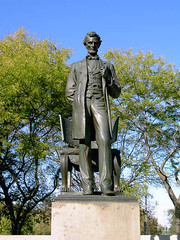 To read an earlier E-Sylum article on the original statue, see:
HAPPY BIRTHDAY TO THE CHICAGO COIN CLUB
(www.coinbooks.org/esylum_v12n09a18.html)
To read an earlier E-Sylum article on the original statue, see:
HAPPY BIRTHDAY TO THE CHICAGO COIN CLUB
(www.coinbooks.org/esylum_v12n09a18.html)
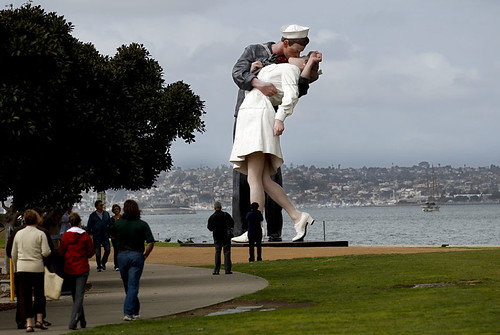
The statue entitled Unconditional Surrender stands tall in the parkway along the waterfront in San Diego. The statue, which was modeled after a photograph by Alfred Eisenstaedt taken in Times Square on V-J Day at the end of World War II, is scheduled to be moved at the end of the month.
H.M.S. VICTORY WRECK MAY HOLD TROVE OF GOLD
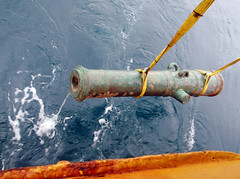 A deal was struck on Wednesday to save what could prove to be one of the richest treasure wrecks of all time.
A deal was struck on Wednesday to save what could prove to be one of the richest treasure wrecks of all time.
Four years ago, in the depths of the English Channel, explorers found the remains of a legendary British warship that sank in 1744 and lost more than 1,000 men. But intruders disturbed the site, dragging and damaging some of the 44 bronze cannons visible on the sandy bottom and hauling one of them away.
The wreck's fate became a topic of public debate in Britain, and not just because of the nation's efforts to preserve its maritime heritage: documents suggested that the warship, the H.M.S. Victory, had carried a secret cargo of gold coins weighing about four tons. If melted down, the gold might be worth $160 million. But if sold for their historic value, the coins might fetch $1 billion.
On Wednesday, the discoverers of the wreck said they had signed an agreement in which they would document and recover the artifacts, ending a long period of uncertainty. They praised the accord as an innovative new way for nations to save historic wrecks.
"We've come up with the model that everybody's been looking for," said Gregory P. Stemm, head of the discovery team and chief executive of Odyssey Marine Exploration of Tampa, Fla., a publicly traded company that specializes in deep-sea exploration and recovery.
In July 1744, the flagship Victory and a fleet of warships were sent to rescue a Mediterranean convoy blockaded by a French fleet at Lisbon. After chasing the French away, the Victory escorted the convoy as far as Gibraltar and then headed home.
A raging storm hit the British fleet shortly after it entered the English Channel, and on Oct. 5, 1744, somewhere off the Channel Islands, the Victory went down with all hands.
A month after the loss, a Dutch newspaper reported that the Victory had been carrying from Lisbon £400,000 destined for Dutch merchants. Odyssey has extensively researched the reliability of that report and concluded that the claimed shipment was most likely genuine and consisted of nearly four tons of gold coins.
In early 2008, Odyssey found the wreck lying at a depth of about 260 feet, beyond the limits of most scuba divers.
Odyssey plans to lower a robot for an archaeological survey of the site and to recover artifacts. The company says the position of every item will be plotted, with the entire project conducted according to the highest scientific and archaeological standards.
To read the complete article, see:
Deal May Yield World's Richest Shipwreck Trove
(www.nytimes.com/2012/02/02/science/wreck-of-british
-ship-victory-may-yield-richest-trove.html)
COINS OF CHARLEMAGNE AND THE POPES
First, a note about links to articles from Coins Weekly. I've noticed that their Article of the Week always has the same URL; it works during the week the article is first published, but the next week it points to a different article.
Once an E-Sylum issue is out the door I have time for little else but the next issue. So I can't promise we'll ever go back and update links in our archive. So be aware of this problem, and if you need the see the original of a Coins Weekly featured article, just search in their archive - it's there somewhere.
With help from Björn Schöpe of Coins Weekly. I learned that the article's permanent URL can be found via a search on their archive, so I've started doing that. The below link is to a permanent URL.

 Pepin the Short, 752-768. Denarius, Angers. Depeyrot 40. From auction Künker 205 no. 1394
Pepin the Short, 752-768. Denarius, Angers. Depeyrot 40. From auction Künker 205 no. 1394
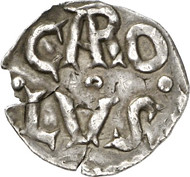
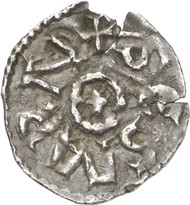 Charlemagne, 768-814. Denarius, Tours (Saint Martin). Depeyrot - (cf. 1051).
Charlemagne, 768-814. Denarius, Tours (Saint Martin). Depeyrot - (cf. 1051).
To read the complete article, see: Charlemagne and the Popes - On the way to the Imperial crown (www.coinsweekly.com/en/Charlemagne-and-the-Popes--On-the-way-to-the-Imperial-crown/8?&id=158&type=a)
THE BOOK BAZARRE
JOHN MCQUEEN'S 1978 MIAMI BEACH AUCTION
One of my customers was a distributor of petroleum products from Nebraska. He would just phone me and say, "John, send me $10,000 worth of silver dollars," or "$15,000 in gold," or "$5,000 in Walking halves." I would choose excellent material and send it off and his check would come by return mail.
As soon as I returned to my office in West Milton, I phoned the gentleman. I said, "Joe [not his real name], you have been buying coins for some time. The market has made a good rise. If I get an auction in Miami Beach, would you sell your coins?" He answered in the affirmative.
I called a man in Cincinnati whom I knew had a major collection. He too said he would consign. It seemed obvious that I would be able to get sufficient material to produce a most satisfactory auction, so I contacted the people in Florida and we were a go.
I called the man in Nebraska to set up an appointment to pick up his collection. I indicated that it would need to be a time convenient to his bank. He said, "Oh no. It's all at home." Sounded extremely risky to me. I asked how much I should insure it for and he hesitated, then said, "Oh about $100,000." I responded that I was certain he was far off the mark. I knew what he had purchased from me and knew that he had bought coins from others. I told him I would insure it for $250,000.
I hired a private detective to go with me and we went out. I knew the man was obviously wealthy, so expected to find a grand house. We found the address given and to say I was surprised would be an understatement. It was a small bungalow overshadowed by huge trees and covered almost completely with ivy.
The owner started pulling coins out of closets, from under beds, from drawers, from everywhere. He said that he had bought two $1,000 bags of silver dollars from the government that he had hidden so well he could not find them yet. He took me to one room that was completely empty. He told me that he had just sold half a million dollars' worth of guns, which had been stored in that room. He had $750,000 worth of guns and coins in his house without even a safe. The coins alone in today's market would be worth about $4.5 million.
Perhaps the reader would be interested in some of the material in the 1978 sale.
There were 115 $20 gold pieces, all from the man in Nebraska. He had paid $50 each for about half of them and $55 for the rest. Can you imagine buying a roll of double eagles today for $1,000? In the sale they averaged $315 each. That would be 600 percent profit in about five years. Talk about buying low and selling high. His collection ended up netting him almost exactly the $250,000 for which I had insured it.
There was a 1908 proof set, which brought $1,375. It would probably bring $5,000 today.
There were two complete sets of Walking Liberty proof sets from 1936 through 1942. One brought $5,900, the other, $6,100. The 1936 set alone today would sell for more than that. There were three other 1936 sets. Do you know of any other auction that has ever had five 1936 sets?
To read the complete article, see: Memorable auction still astounding (www.numismaticnews.net/article/memorable-auction-still-astounding)
HARVEY STACK REMEMBERS HAROLD BAREFORD
The dinners held at the end of each show became a "roast" of the Stacks, who always arrived late because of the closing of each auction. Harold Bareford, who served as master of ceremonies, always jested at dinner: "I guess you guys were too busy counting your profits from your sale to be on time for dinner! I'm hungry, so sit down so we all can eat!" This was a typical friendly-sarcastic remark one would hear from Harold.
Alan V. Weinberg writes:
I met Harold when he was an elderly man, presumably in his late 70's, early 80's, short, perhaps 5' 5" as I recall in a dark suit and tie, silvery hair . I was studying some really magnificent early US coins on exhibit on the balcony overlooking the annual NY Metropolitan coin show at the Park Sheraton in the very early 60's.
He stood behind me and asked if I liked what I saw. I said "yes, wonderful coins" as I took notes. I distinctly recall a superb 1793 Liberty Cap large cent. He introduced himself as the owner. Little did I or he know that someday I might own some equally impressive coins.
To read the complete article, see: Remember When: Harvey Stack Remembers The 1940s (stacksbowers.com/Blogs/remember-when-harvey-stack-remembers.html)
OBAMA AWARDS NATIONAL MEDALS OF ARTS HUMANITIES
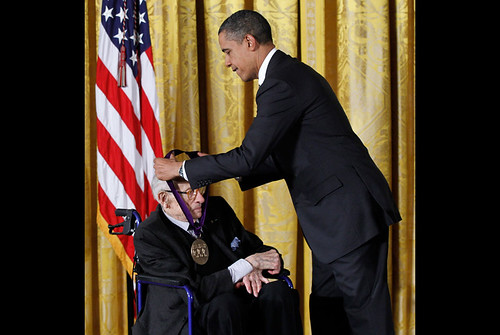
Obama presents National Medal of the Arts to Will Barnet
President Barack Obama on Monday honored several artists, writers and organizations for their contributions to the nation, and pledged to make the arts and humanities a priority for as long as he is in the White House.
Obama bestowed eight National Medal of Arts and nine National Humanities Medals during a ceremony in the White House East Room. Among this year's recipients were actor Al Pacino, poet Rita Dove and the United Service Organization, which holds performances for American service members stationed around the world.
Before awarding the medals, Obama said the arts have the power to bring together people of different backgrounds and beliefs. And he urged the honorees to help mentor a new generation of artists and scholars, saying their role in the nation's future would be equally as important as the next generation of engineers and scientists.
"The arts and humanities do not just reflect America, they shape America," Obama said. "As long as I'm president, I look forward to making sure they are a priority for this country."
Others receiving arts medals:
Will Barnet, painter, printmaker and teacher • Emily Rauh Pulitzer, curator, art collector and philanthropist • Martin Puryear, sculptor • Mel Tillis, singer-songwriter • André Watts, pianist and teacher.
Receiving medals for the humanities:
Kwame Anthony Appiah, philosopher and novelist • John Ashbery, poet • Robert Darnton, author and librarian • Andrew Delbanco, social critic and professor • National History Day, program that celebrates history • Charles Rosen, pianist and author • Teofilo Ruiz, historian and professor • Ramón Saldívar, writer and professor • Amartya Sen, economist.
To read the complete article, see: President Barack Obama honors achievements and contributions in arts, humanities (www.artdaily.org/index.asp?int_sec=2&int_new=53598)
FIRST EXAMPLE OF GLOUCESTER-MINTED COIN OF WILLIAM I FOUND
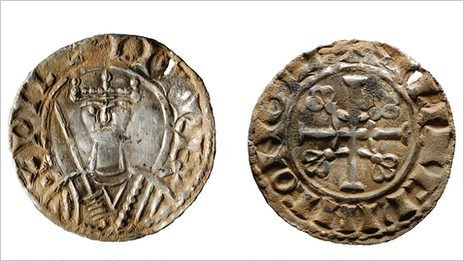
A "unique" medieval coin from the reign of William the Conqueror has been discovered in a field near Gloucester.
The hammered silver coin was found by metal detectorist Maureen Jones just north of the city in November.
Experts from the Portable Antiquities Scheme said the find "filled in the hole" in the dates the Gloucester mint was known to have been operating.
The coin, which dates from 1077-1080, features the name of the moneyer Silacwine and where it was minted.
The Portable Antiquities Scheme said that until the coin was discovered, there were no known examples of William I coins minted in Gloucester between 1077-1080.
"The discovery of this coin therefore proves that the mint was in operation throughout the whole reign of William I," it said.
To read the complete article, see: 'Unique' 11th Century coin discovered near Gloucester (www.bbc.co.uk/news/uk-england-gloucestershire-17027300)
GOLD COIN STASH RAINS FROM RAFTERS IN FRANCE
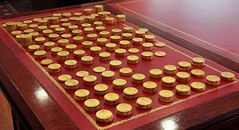 A French Champagne producer is spreading the wealth with his workers after they discovered nearly $1 million in gold coins stashed away in the building's rafters, according to Agence France Press (AFP).
A French Champagne producer is spreading the wealth with his workers after they discovered nearly $1 million in gold coins stashed away in the building's rafters, according to Agence France Press (AFP).
"One of the workers (was) attacking the building's ceiling with a crowbar when gold coins started to rain down on him, followed by sacks of gold," Francois Lange, head of Alexandre Bonnet in Les Riceys France, told AFP.
It's not unusual to hear about treasure hunters combing the ocean's depth for gold and other precious metals lost at sea, but finding $1 million in your office attic is quite a steal. And a valuable one too, given that demand for gold has reached new heights recently. In 2011, just an ounce of gold was valued at $1,920.30.
In all, 497 gold coins were unearthed, with the majority literally raining down upon the workers who were busy renovating the building. Minted between 1851 and 1928, the coins have a face value marking of $20 each. However, together they are now worth an estimated $980,000, according to AFP.
Lange says he will keep half of the money for himself, while splitting half with the workers who made the discovery. No one knows for sure who placed the coins in the building, but AFP reports the building was previously owned by a wine producer in the 1930s.
That may seem like a minor detail for now but don't be surprised if this "buried" treasure story still has another chapter to be told. After all, what are the odds that $1 million in gold coins will go unclaimed, even if the previous owners are no longer alive. Just look at the recent legal case being argued between Spain and a team of scavengers who in 2008 found more than $500 million worth of gold coins and other treasures in a wreck off the Florida coast.
To read the complete article, see:
Secret $1 million gold stash discovered in French rafters
(news.yahoo.com/blogs/sideshow/raining-gold-secret
-1-million-gold-stash-discovered-203724430.html)
SPECULATORS FUEL BANK OF CHINA COMMEMORATIVE NOTE FRENZY
 Frenzied scenes erupted outside Bank of China branches in Hong Kong as speculators dived in to make a killing on new banknotes.
The special notes - commemorating the bank's centenary - changed hands for more than six times their value immediately after.
Frenzied scenes erupted outside Bank of China branches in Hong Kong as speculators dived in to make a killing on new banknotes.
The special notes - commemorating the bank's centenary - changed hands for more than six times their value immediately after.
People determined to get their hands on the notes, which are selling like hot cakes, again queued overnight to be first in line when the banks open this morning.
Yesterday, the branch at Olympian City stopped services when the fast buck mayhem outside threatened to get out of control.
Most of the notes - or 1,100,000 sets - are single HK$100 notes costing HK$150 each.
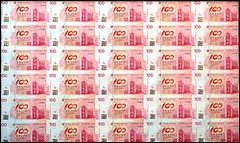 There are also 100,000 sets of uncut three-note sheets for HK$600, and 20,000 sets of uncut 30-note sheets at HK$6,000.
There are also 100,000 sets of uncut three-note sheets for HK$600, and 20,000 sets of uncut 30-note sheets at HK$6,000.
Long queues formed outside some branches from late on Sunday as speculators joined collectors.
The frenzy at Olympian City turned to chaos after a man claimed he spent HK$70,000 buying 77 purchase slips from people in the queue - only to find out they could be used only by the original holders.
Earlier in Central, a man named Tong said he arrived with his mother at 8am yesterday to find hundreds in the queue already. "The first man in the queue arrived at 11pm on Sunday," he said. "He brought along his sleeping bag."
Tong eventually bought four single HK$100 notes for HK$600 - two to sell through internet auction sites and two to keep.
He expects the selling price to soar next week when the stocks are sold out.
Another man in the queue, Wong, bought four sets but said they were for his family and not to make quick money. "These banknotes mark the bank's centenary and are worth collecting," he said.
He bought special Olympic banknotes in 2008 and the Standard Chartered's 150-year commemorative issue in 2009.
Banknote dealer Chan Wing-fai, who runs two coin and stamp shops in Mong Kok and Lam Tin, said he bought about 1,000 sets, which he immediately sold to a mainland souvenir company for HK$200,000.
But he said the HK$1,000 being demanded by some speculators for the banknotes is high and could drop soon.
"I expect the price will be around HK$600 rather than HK$1,000 when demand slackens," he said.
To read the complete article, see:
Notes of frenzy
(www.thestandard.com.hk/news_detail.asp?
we_cat=11&art_id=119689&sid=35405896&
con_type=3&d_str=20120214&fc=1)
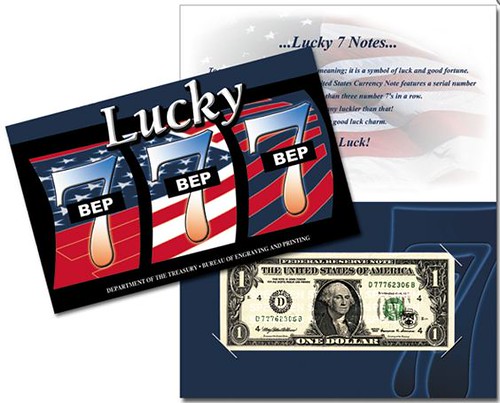
To visit the BEP products page, see www.moneyfactorystore.gov
NEW DOCUMENTS RECOUNT NAZI COUNTERFEITING DAMAGE

Nazi forgers succeeded in flooding Europe with fake British bank notes, "destroying" confidence in the UK currency, according to secret MI5 files made public today.
Papers released by the National Archives show that by the end of the Second World War the forgeries were so rife, British bank notes would not be accepted on the Continent.
The Germans first began forging the notes in 1940 in preparation for Hitler's planned invasion of Britain, according to a report drawn up in 1945 by Sir Edward Reid of MI5's section B1B.
According to a captured German agent, the plan was to scatter the notes over the country from the air "in order to create loss of confidence and general confusion".
Although Hitler was forced to abandon his invasion plan after the failure of the Luftwaffe to gain aerial supremacy in the Battle of Britain, the German forgers carried on perfecting their techniques to devastating effect.
"What they subsequently produced was a type of forgery so skilful that it is impossible for anyone other than a specially trained expert to detect the difference between them and genuine notes," Reid reported.
Initially the fake notes were circulated in neutral Portugal and Spain with the double objective of raising money for the Nazi cause and creating a lack of confidence in the British currency. Subsequently they began turning up as Egypt as well.
By 1944, the British authorities were so alarmed at the impact they were having, they informed the Spanish government who seized £20,000 in British notes from German agents - all of which turned out to be forged.
To read the complete article, see:
Secret MI5 Papers Reveal Nazi Plot To Flood UK With Fake Bank Notes
(www.huffingtonpost.co.uk/2012/02/16/secret-mi5
-papers-reveal-nazi-banknote-plot_n_1281589.html)
To read an earlier E-Sylum article, see: OPERATION BERNHARD COUNTERFEITER ADOLF BURGER INTERVIEWED (www.coinbooks.org/esylum_v12n10a24.html)
FAKE U.S. BONDS SEIZED IN ZURICH
 Italian anti-mafia prosecutors said they seized a record $6 trillion of allegedly fake U.S. Treasury bonds, an amount that's almost half of the U.S.'s public debt.
Italian anti-mafia prosecutors said they seized a record $6 trillion of allegedly fake U.S. Treasury bonds, an amount that's almost half of the U.S.'s public debt.
The bonds were found hidden in makeshift compartments of three safety deposit boxes in Zurich, the prosecutors from the southern city of Potenza said in an e-mailed statement. The Italian authorities arrested eight people in connection with the probe, dubbed "Operation Vulcanica," the prosecutors said.
The U.S. embassy in Rome has examined the securities dated 1934, which had a nominal value of $1 billion apiece, they said in the statement. "Thanks to Italian authorities for the seizure of fictitious bonds for $6 trillion," the embassy said in a message on Twitter.
The financial fraud uncovered by the Italian prosecutors in Potenza includes two checks issued through HSBC Holdings Plc (HSBA) in London for 205,000 pounds ($325,000), checks that weren't backed by available funds, the prosecutors said. As part of the probe, fake bonds for $2 billion were also seized in Rome. The individuals involved were planning to buy plutonium from Nigerian sources, according to phone conversations monitored by the police.
To read the complete article, see:
$6T of Fake U.S. Bonds Seized in Mafia Probe
(www.bloomberg.com/news/2012-02-17/italy-police
-seize-6-trillion-of-fake-u-s-treasury-bonds-in-switzerland.html)
FEATURED WEB SITE: THE TOKEN AND MEDAL SOCIETY
This week's Featured Web Site is the home of The Token and Medal Society (TAMS).The Token and Medal Society, Inc. is an educational and non-profit organization devoted to furthering the exonumia field consisting of all forms of tokens, medals, badges and other items of a related nature. The aims of TAMS are:
- To promote and stimulate the study of tokens and medals
- To cultivate fraternal collector relations
- To encourage research and articles and recordings pertaining thereto
- To disperse information and knowledge in a society's journal
- To advance interest and prestige
- To promote meetings at conventions
- To promote and encourage distinct classifications at exhibits
- To endeavor to determine values of rarities
- To permanently record historical information relating to tokens and medals by publishing original works by members, and by reprinting old works not readily available to present day collectors.

www.tokenandmedal.org

